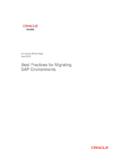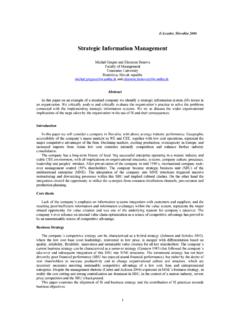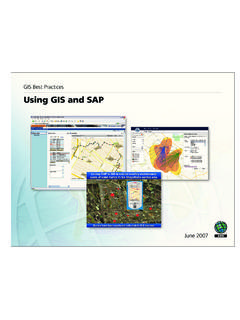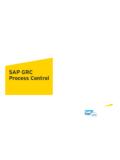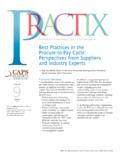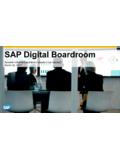Transcription of Licensing sAP® Products: A guide for Buyers - …
1 SAP Licensing GuideLicensing sAP Products: A guide for BuyersUnderstanding How to License saP software Disclaimerthis document is proprietary information of saP and is subject to change without notice. it is to be distributed by saP only and is not to be copied, distributed, or reproduced in whole or in part without the express written consent of document is for educational purposes only. none of the statements in this document are legally binding and they cannot be used for contractual purposes. this document does not amend, substitute, or replace your current saP Licensing terms and conditions or any end-user license 4 Part I SAP Licensing in a Nutshell 51 How to License SAP Software Products: An Overview core elements of the saP Licensing Model Modular structure of saP software Licenses flexible Payment through saP financing alternative Licensing Models 72 Customer Examples: Basic Licensing Scenarios scenario 1: need for reliable, integrated it infrastructure scenario 2.
2 Deploying saP Businessobjects software as stand-alone solutions 10 Part II SAP Licensing The Complete Picture 121 The SAP Solution Portfolio 122 Key Principles of Licensing and Pricing software Licenses and Maintenance services Package Licenses and named User Licenses Licensing Principles for saP Business suite Licensing Principles for saP Businessobjects software Licensing Principles for saP netweaver Licensing Principles for databases 243 Special Licensing Topics interfaced access to saP software cPU-Based Metrics and Virtualization scenarios existing contract types nonproductive Licenses saP Best Practices Modifications and add-ons 314 Customer Examples: Advanced Licensing Scenarios scenario 3: extension of existing saP software footprint scenario 4: integration of software with saP netweaver scenario 5: saP functionality for crM stand-alone solution 38 Glossary 39thank you for your interest in the important topic of software Licensing and pricing at saP.
3 This document is part of a broader initiative to enhance transparency into how saP licenses its software. it provides you with a wealth of infor-mation designed to help you make more informed invest-ment decisions in line with your specific business the main sections of this guide , you will find information on the standard Licensing model for saP Business suite appli-cations, the saP netweaver technology platform, and the saP Businessobjects portfolio. introduced in 2006, this model is an evolution of earlier saP Licensing approaches. the inclusion of saP Businessobjects solutions is a recent enhancement. saP s current Licensing model is valid for new and existing customers and, with certain exceptions, those holding contracts signed before software requirements vary considerably. to help you find the information that best meets your needs, this guide presents a wide variety of Licensing scenarios. it is divided into two main parts.
4 Where you choose to begin reading will depend on how familiar you are with saP s Licensing you are a relative newcomer to Licensing saP software, Part i is the place to start. in addition to a high-level over-view of the Licensing principles, it includes basic customer examples that illustrate you are already acquainted with saP s Licensing model, you can go directly to Part ii. this contains a more detailed view of the principles outlined in part one. it also presents topics of interest to customers who already hold an saP contract. and it includes advanced Licensing scenarios based on real-life customer included is a glossary. this gives you easy access to brief definitions of key hope you will find this guide useful. if you have any questions about Licensing , pricing, or related topics, feel free to contact your saP 41 How to License SAP Software Products: An OverviewBefore Licensing any software, it s important to understand your vendor s Licensing and pricing model.
5 Gaining this in-sight enables you to make better investment decisions and tailor software solutions to your business needs. saP bases its Licensing on clearly defined principles that benefit both saP and you the customer. this section provides you with a high-level introduction to saP s Licensing model, its key elements, and their advantages for you. the principles explained below apply to saP Business suite software, most solutions in the saP Businessobjects portfolio, and the saP netweaver technology platform. core elements of the saP Licensing ModelsaP s standard Licensing model comprises two fundamental elements: software licenses and associated maintenance and support services. these are offered separately. Most saP software licenses are perpetual licenses, which entitle you to use the relevant functionality for an unlimited your saP solution is in place, you want to make sure it runs smoothly and keeps pace with changing business and statutory requirements.
6 To meet these needs, saP offers maintenance and support services for most of its software. By signing a maintenance contract, you gain access to the saP support infrastructure, important updates, and new releases of your licensed software. any investment in enterprise software has to deliver tangible business value. the saP solution portfolio is designed to do just that. comprising saP Business suite, with its tailored industry functionality, saP Businessobjects solutions, and the saP netweaver technology platform, the saP portfolio helps you automate, harmonize, and streamline business processes. what s more, it helps your employees perform their day-to-day tasks more efficiently. the structure of saP software licenses is intended to maximize these inherent business benefits by providing package licenses and named user licenses. Both are required in order to license saP software. with its firm focus on value, this Licensing model allows you to make a persuasive business case for your software license and helps maximize the return on your it LicensesPackage licenses entitle you to use the precise set of soft-ware functionality (the content of the package) that you need to support your company s processes.
7 The price of a pack-age license is based on key business metrics that reflect your use of that functionality. saP determined these metrics in close collaboration with customers in order to make sure they reflect a business s real-world requirements. examples include the number of orders processed, number of con-tracts tracked, gross written premiums, or patients treated. as your business grows, you can scale the functionality as your requirements i sAP Licensing in A nutsheLL5 Named User Licensesin addition to package licenses, you require a named user license for each user who will access the licensed functional-ity. a named user is an employee of your organization or one of its affiliates or a business partner who is authorized to access the licensed saP software directly or indirectly. one major benefit of the saP named user licenses is that they can be valid for multiple package licenses. this means that even if your employees handle complex business pro-cesses involving a wide range of saP functionality, you require only one named user license per employee.
8 What s more, when you introduce new packages, existing named users usually have the right to access the associated functionality. How your employees work with an saP solution will vary depending on their tasks and roles within your organization. to reflect this, saP offers different categories of named user licenses. they include saP Professional for users fulfilling operational-related roles supported by the software and saP employee, which includes employee Modular structure of saP software LicensesBusiness never stands still. so you want to be sure your saP solution can be scaled in line with your changing needs. the modular structure of saP software licenses allows you to license and pay for only the functionality and users you require at any given time. this means that you don t have to take a big-bang approach, but can start with the package and named user licenses your organization needs today and add more functionality and users as your needs change.
9 For example, Licensing additional functionality is straightfor-ward. to begin, you can establish a solid basis for operations by Licensing core functionality for financial management, human capital management, and procurement and logistics. as you extend your organization s it infrastructure to cover more of your business processes, you can license additional packages to support those further areas of operation, for example, industry-specific Licensing in A nutsheLLPackage LicensesEntitle you to deploy and use specific sets of software functionalityPriced by business metricsnamed user LicensesEntitle the users to access the licensed software functionalityPriced by number of usersPackages and user licenses cannot be used independently from each other.+Figure 1: Package Licenses and Named User Licenses6the on-demand delivery model is ideal if you lack the it infrastructure required to run your saP software in-house, or if you simply prefer to outsource your an on-demand solution, you pay a recurring subscription-based Licensing fee calculated on a per-user, per-month basis.
10 This gives you remote access to the relevant saP software for a specified period of time. the license also entitles you to support, maintenance, and managed services as set out in your read this section, you should now have a sound grasp of the basic principles of the Licensing model saP offers. in the following section, you can see these principles in action in different customer scenarios. for details on saP Licensing and associated topics, you can proceed to Part ii: saP Licensing the complete Picture. Licensing additional users is every bit as straightforward. for example, you might initially deploy saP software functionality for financial management, with named user licenses for relevant staff members in your finance depart-ment. as your business grows, additional employees may come to play a role in financial processes. giving them access to the software is simply a matter of adding the required number of named user licenses.

